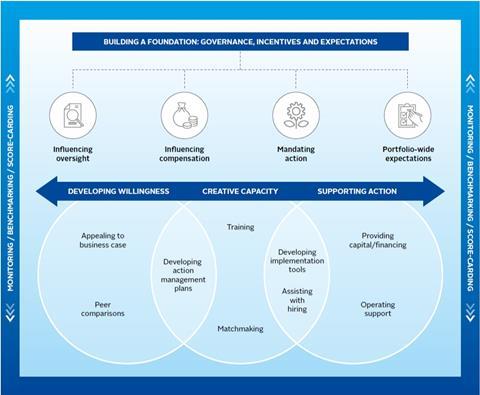This guide aims to help private equity general partners execute stewardship of their portfolio companies, partly by highlighting best practices for both beginners and leaders in stewardship. It walks the reader through whom, when and on what to engage and provides a practical toolkit addressing the how of engagement.
Executive summary
The PRI defines stewardship as the use of influence by investors to maximise long-term value, including the value of economic, social, and environmental assets on which returns and client and beneficiary interest depend. This definition is reflected in Principle 2 of the PRI’s six Principles, which asset owners and investment managers commit to upon becoming signatories:
We will be active owners and incorporate ESG issues into our ownership policies and practices.
For many private equity GPs, transforming companies is a fundamental part of their business model and a key way that they deliver value and meet their fiduciary duty to clients. By the simple nature of their investment style and deal/ownership structure, private equity GPs frequently have significant influence over their investments and thus a high capacity to make a lasting impact on the economic, environmental and social value of their portfolio companies.
Despite the natural fit between stewardship and private equity, private market investors repeatedly stated, during our 2021 Reporting Framework survey, that stewardship was a concept that did not apply to the asset class. As we examined this contradiction, it became clear that many private equity GPs may be doing stewardship without naming it as such. Some GPs struggle to connect aspects of their traditional value creation activities with stewardship. Others anchor the terminology to its meaning for listed equity investors and write the practice off as not specific or powerful enough to capture the nature of their activities and impact.
The research for this paper showed GPs need clearer guidance on what constitutes stewardship in private equity, which could also weed out activities that are incorrectly counted as stewardship. In this paper, we have provided that clarity and laid out a set of stewardship actions that general partners can take across the investment life cycle, addressing the when, who, what and how of effective engagement.
When: We map out when key actions of GP-to-portfolio-company engagement occur. Most efforts will occur during the holding period, but important actions can set an engagement up for success in the pre-investment phase – this is especially true for minority co-investors. We look in detail at the due diligence process, deal documentation and how exit strategies can shape engagement activities during the holding period. We also review tactics that can help ensure engagement successes persist after the investor has exited the investment.
Who: In a matrix of relationships between the private equity GP and the portfolio company we have shown that investment committee/deal team buy-in is critical to the success of engagements. A number of strategies are available to achieve such buy-in, including endorsement of ESG focus from the GP’s top management team, training programs for deal teams and investment committee members and making ESG a regular part of analyst inductions.
What: GPs determine areas of engagement in one of two ways – a bespoke approach to each company or having a set of ESG priorities that the GP will pursue at every company. The report lists factors for GPs to consider under each approach. It goes on to explore the opportunities private equity investors have to address systemic risks through a focus on sustainability outcomes.
How: The paper concludes by exploring the many tools GPs can use in stewardship efforts with portfolio companies, including:
- Establishing expectations, governance and incentive mechanisms
- Engendering a company’s willingness to change
- Building the company’s capacity to change
- Supporting a company in acting on the desired change.
Efforts to monitor and benchmark performance against ESG goals cut across these tools. The report also reviews escalation options if original stewardship efforts are unsuccessful.
The final section of the paper broadens the lens to consider how GPs can help transform capital markets. The tools we explore include public policy engagement, contributing to public goods and influencing standards through collaboration.
The GP Toolbox to facilitate successful company engagements

GPs that do stewardship well report experiencing significant upsides. These include enhanced client relationships, a positive impact on company earnings and exiting positions at a higher multiple. Several GPs even shared that having strong ESG stewardship capabilities helped them with deal flow or closing competitive deals.
We hope this guide, available for download below, will assist GPs to improve upon existing, or develop new, stewardship practices so that many more GPs can experience the benefits reported to us by our consultation group. Furthermore, we believe that improved practices on stewardship in private equity can unlock the potential of this asset class to contribute to achieving a more sustainable financial system.
About this guide
This guide is aimed at helping private equity general partners (GPs) plan and execute stewardship of their portfolio companies. It seeks to aid private equity investors by:
- Explaining what stewardship means for this asset class, including practical examples;
- Serving as a how-to guide for GPs that are just getting started with stewardship objectives;
- Highlighting best practices for both beginners and leaders in stewardship;
- Homing in on opportunities to better align with sustainable outcomes.
The target audience includes GPs that are majority investors (such as in buy-out strategies) and minority investors (such as in growth and co-investment strategies). Although this guide does not explore stewardship from the limited partner (LP) point of view, LPs may find this guide useful in assessing general partners. Aside from their role as periodic co-investors, the paper also excludes fund-of-funds and secondaries investors – which resemble LPs in their approach.
The content is based on: a detailed review of responses to the 2021 and 2023 Reporting Frameworks from private equity investors; a stewardship practices survey of members of the 2022-23 Private Equity Advisory Committee; and a series of interviews with private equity practitioners. Excerpts from these interviews are highlighted throughout.
This guide complements other PRI content relating to responsible investing in private markets, particularly in private equity, that we began publishing in 2014:
- Integrating ESG in Private Equity, A Guide for General Partners
- Introduction to responsible investment: private equity
- Responsible investment DDQs for private equity and venture capital limited partners
- Guide for limited partners: responsible investment in private equity
- TCFD for private equity general partners
- The Private Credit and Private Equity ESG Factor Map
- Guidance for private equity signatories: directors’ duties and ESG (versions available for UK and US directors)
Links to other relevant PRI content are provided throughout and a further reading list is provided at the end of the paper. All feedback is welcome – please contact us at [email protected].
CREDITS | Author: Carly Jacobs, CFA | Editor: Casey Aspin | Design: Will Stewart.
Downloads
Stewardship in private equity: A guide for general partners
PDF, Size 0.65 mb私募股权尽责管理-普通合伙人指南 - Stewardship in private equity (Chinese)
PDF, Size 1.15 mb












